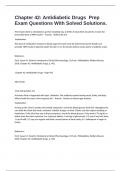Chapter 42: Antidiabetic Drugs Prep
Exam Questions With Solved Solutions.
The female client is scheduled to get her breakfast tray at 0700. At what time should she receive her
prescribed dose of NPH insulin? - Answer 0630 (6:30 am)
Explanation:
The dose of medication is based on blood sugar level and must be determined by the health care
provider. NPH insulin is injected under the skin 15 or 30 minutes before meals and/or a bedtime snack.
Reference:
Ford, Susan M., Roach's Introductory Clinical Pharmacology, 11th ed., Philadelphia, Wolters Kluwer,
2018, Chapter 42: Antidiabetic Drugs, p. 492.
Chapter 42: Antidiabetic Drugs - Page 492
Add a Note
2 See full question 11s
A female client is diagnosed with type 1 diabetes. She suddenly reports feeling weak, shaky, and dizzy.
What should the nurse's first response be? - Answer Perform a blood sugar analysis.
Explanation:
As long as the client is awake and verbally responsive, check the blood glucose level first. Hypoglycemia
can make the client feel weak, confused, irritable, hungry, or tired. Clients may also report sweating or
headaches. If the client has any of these symptoms, check the blood glucose. If the level is 70 mg/dL or
below, have the client consume 3 or 4 glucose tablets; 1 serving of glucose gel; 1/2 cup of any fruit juice;
1 cup of milk; 1/2 cup of a regular soft drink; several pieces of hard candy; or 1 tablespoon of sugar or
honey.
Reference:
Ford, Susan M., Roach's Introductory Clinical Pharmacology, 11th ed., Philadelphia, Wolters Kluwer,
2018, Chapter 42: Antidiabetic Drugs, p. 490.
,Chapter 42: Antidiabetic Drugs - Page 490
Add a Note
3 See full question 14s
Which medication would a nurse identify as a noninsulin injectable antidiabetic drug? - Answer
exenatide
Explanation:
Exenatide and pramlintide are noninsulin injectable antidiabetic drugs. Sitagliptin, glipizide, and
pioglitazone are oral agents.
Reference:
Ford, Susan M., Roach's Introductory Clinical Pharmacology, 11th ed., Philadelphia, Wolters Kluwer,
2018, Chapter 42: Antidiabetic Drugs, p. 487.
Chapter 42: Antidiabetic Drugs - Page 487
Add a Note
4 See full question 1m 10s
An insulin-dependent diabetic male client is having trouble with hypoglycemia late in the morning.
During the health history, the nurse becomes aware of the most likely cause. What would cause the late
morning hypoglycemia? - Answer The client jogs two miles in the morning before he goes to work.
Explanation:
Physical exercise, such as jogging, changes insulin requirements and may result in a delayed
hypoglycemic reaction. The fact that he likes to nap before dinner and has an early lunch is unrelated to
his hypoglycemia. The client eating oatmeal early in the morning would help stabilize his blood sugars
until later in the morning, but the jogging would have a dramatic effect.
Reference:
Ford, Susan M., Roach's Introductory Clinical Pharmacology, 11th ed., Philadelphia, Wolters Kluwer,
2018, Chapter 42: Antidiabetic Drugs, p. 496.
, Chapter 42: Antidiabetic Drugs - Page 496
Add a Note
5 See full question 26s
In what condition is human insulin not recommended for diabetic clients? - Answer Type 2 diabetes
controlled by diet
Explanation:
Insulin is recommended for treatment of type 2 diabetes mellitus in clients whose diabetes cannot be
controlled by diet or other agents. If the diabetes can be controlled by diet, the pancreas is still
functioning and releasing insulin. Type 2 diabetes is characterized by hyperglycemia and insulin
resistance. The hyperglycemia results from increased production of glucose by the liver and decreased
uptake of glucose in liver, muscle, and fat cells. Insulin resistance means that higher-than-usual
concentrations of insulin are required. Thus, insulin is present, but unable to work effectively at the
cellular level. Diet control requires a reduction of ingested calories, which lowers the serum glucose
levels. Human insulin can be used in gestational diabetes, type 2 diabetics controlled on oral antidiabetic
agents with systemic infection, or type 1 diabetics of many years.
Reference:
Ford, Susan M., Roach's Introductory Clinical Pharmacology, 11th ed., Philadelphia, Wolters Kluwer,
2018, Chapter 42: Antidiabetic Drugs, p. 486.
Chapter 42: Antidiabetic Drugs - Page 486
Add a Note
6 See full question 10s
A diabetic client has just received an insulin pump. What would be important to include in client
teaching? - Answer Check blood glucose frequently.
Explanation:
The device does have several disadvantages. The tubing is awkward, use of the tubing poses an
increased risk of infection and requires frequent changing, and the client has to frequently check blood




